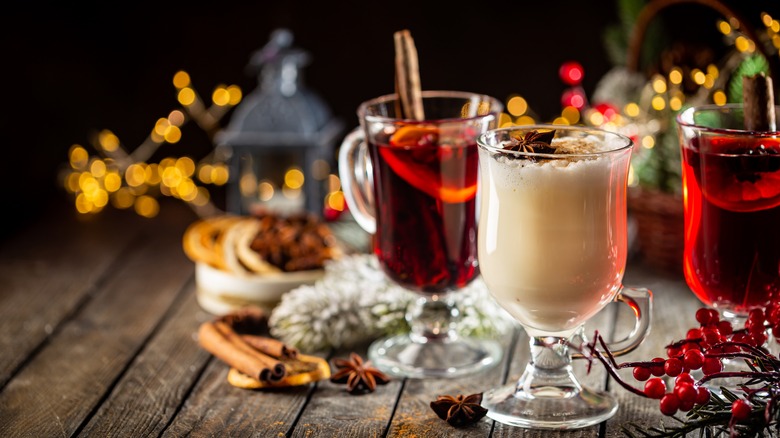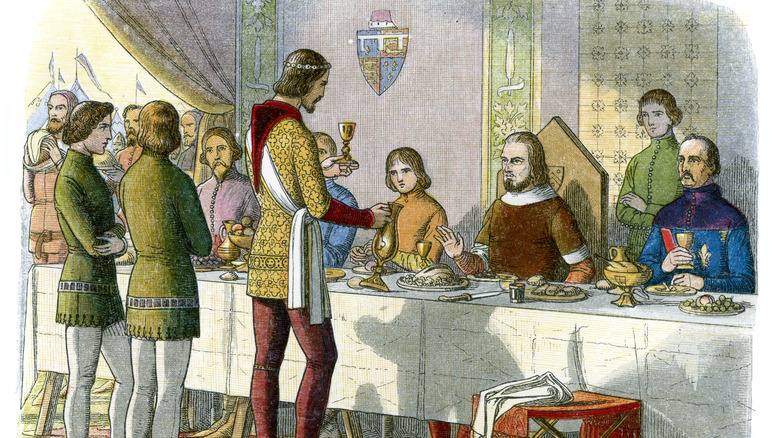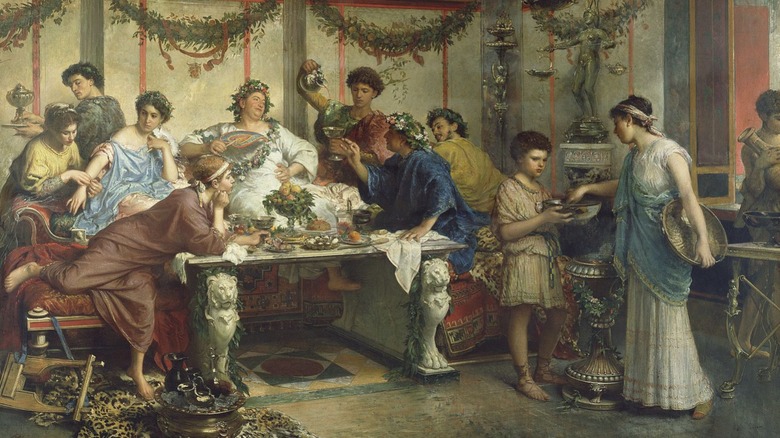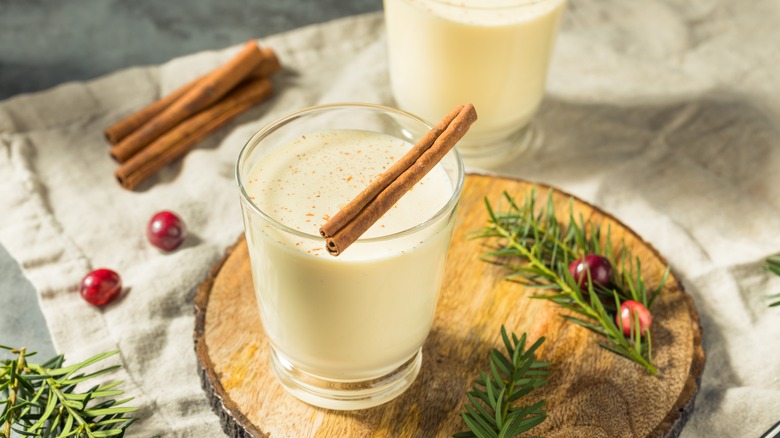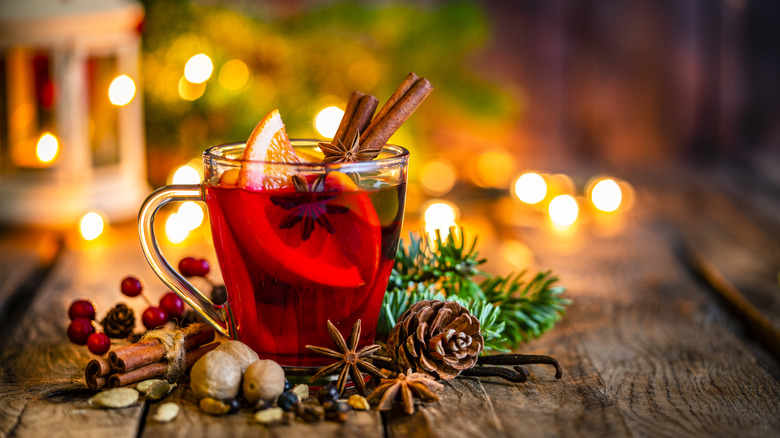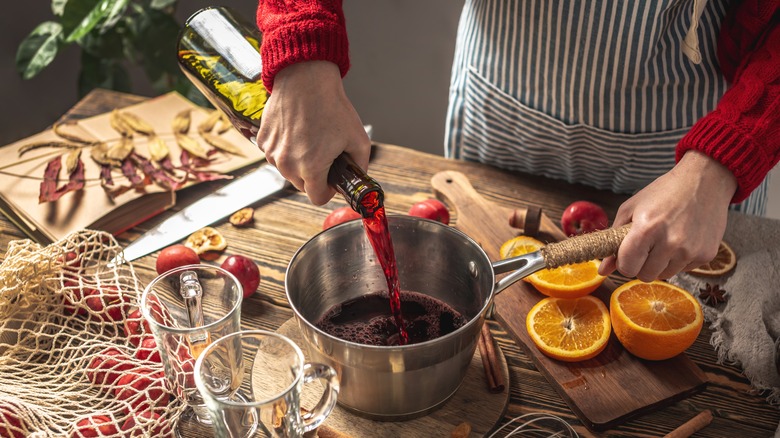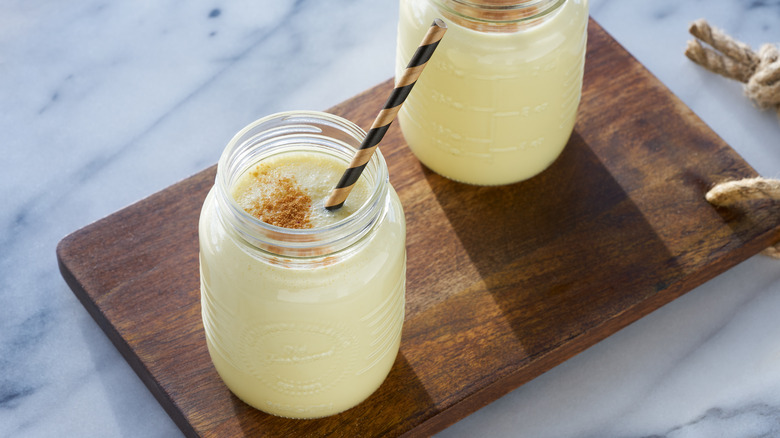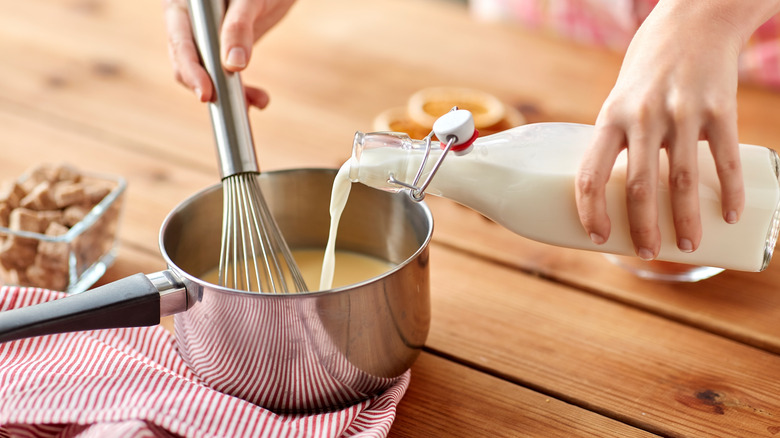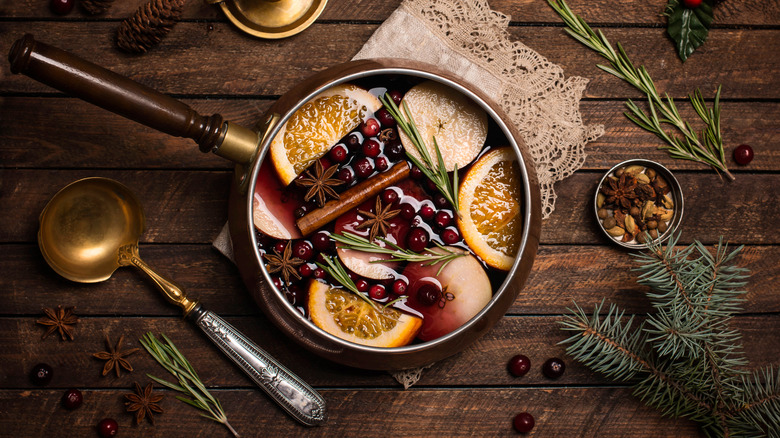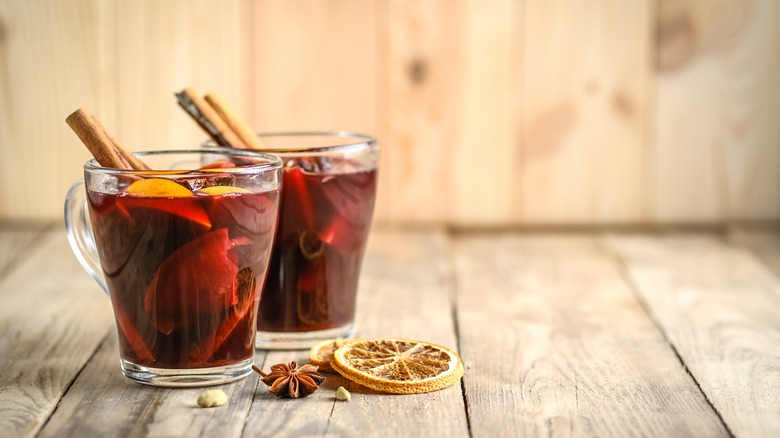Eggnog Vs Mulled Wine: Your Guide To The Popular Holiday Drinks
Winter weather and holiday music herald the return of eggnog and mulled wine, and depending on where you are in the world, you might have strong opinions about which is better. Eggnog is a rich, decadent beverage made with eggs, milk, and cream that is popular in the United States. It's so rich that you probably couldn't drink more than a glass or two at a time without feeling ill, but somehow it's still worth it. Mulled wine is a hot beverage made of red wine steeped in spices and citrus. It's the kind of drink that will warm you to your bones, no matter the weather, which makes it the ideal drink for outdoor markets in Europe.
Both beverages have distinct histories and cultural significance. While eggnog may be the ubiquitous holiday drink in the U.S., its popularity is dwarfed by mulled wine in Europe. Pitting these two giants of the festive season against each other would do them both a disservice, so instead, we're outlining their differences so you can pick which (if not both) to make this holiday season.
Eggnog originates from Medieval England
Despite its reputation as America's favorite holiday drink, eggnog likely originated from a beverage in Medieval England called posset. It was a warm mixture of curdled milk and ale or wine that was served only to the upper classes due to the lack of refrigeration and the exorbitant cost of dairy. As if curdled milk and warm beer weren't bad enough, raw eggs were incorporated over time, probably by monks.
Not surprisingly, posset dwindled in popularity over time, and it wasn't until enterprising colonists in what would become the United States took up the cause that it finally morphed into the silky beverage that we know and love today. Slowly but surely, the drink became more palatable. Fresh eggs and dairy were plentiful in North America, since many colonists had their own farms, and warm ale and wine were replaced with the more readily available (and delicious) options of whiskey and rum. The resulting beverage even got a new name: eggnog. Where the "nog" comes in is a matter of dispute. It may have been a reference to a British word for strong ale, but given that liquor had become the alcohol of choice by that time, it seems more likely that it was named after wooden cups known as "noggins." Either way, by the 19th century, Americans could claim eggnog as their own.
Mulled wine originates from Ancient Rome
Mulled wine is even older than eggnog. In Ancient Rome, it was called Conditum Paradoxum, "surprise wine." The "surprise" was probably the combination of spices. In addition to white wine and honey, they added pepper, mastic (a pine-scented resin), saffron, bay leaves, and date pits. Romans were known to drink the resulting concoction during their Winter Solstice celebrations to ward off the cold in style. When Paganism gave way to Christianity in many parts of Europe, the tradition stuck, and spiced wine transitioned from a solstice drink to a Christmas one.
While English aristocrats in the Medieval period were sipping posset, their counterparts in Spain and France had been glugging spiced wine for centuries. Throughout Europe, there are many variations of mulled wine, but saffron, bay leaves, and mastic have given way to the more popular spices including cloves, cinnamon, and star anise.
Eggnog contains cozy spices like nutmeg and cinnamon
Eggnog is broadly appealing, even for those who aren't fond of spices. Its pleasantly mild taste is true to the original recipes for posset, which usually limited their aromatic ingredients to nutmeg, cinnamon, and mace, the light coating around the nutmeg seed.
Despite America's love of cinnamon, nutmeg is the predominant flavor in most eggnog recipes. Its bright, slightly spicy flavor lightens the heaviness of the cream and eggs, while a hint of cinnamon keeps things recognizably Christmassy. This spice combination is especially important in versions of eggnog that do not contain alcohol. Without the kick of spices or liquor, eggnog would be an unflavored milkshake with eggs, something which probably wouldn't induce cravings at any time of year. For a spicier eggnog, it's better to simply dial up the nutmeg and cinnamon than to muddy the flavors with too many ingredients. Cloves can enhance the heat, but eggnog thrives on the simple, cozy comforts of nutmeg and cinnamon.
Mulled wine contains a bold and varied mix of spices
In contrast, mulled wine is all about the spices. Because it's an adult beverage, it can take a bolder approach to flavor. In Europe, you can buy a vast array of mulled wine spice mixes during the holiday period. Most of them contain dried orange peel and cloves, while allspice, cinnamon, nutmeg, and cardamom are also popular.
The spice profile also varies by country. Nordic gløgg, for example, tends to have ginger and cinnamon. German glühwein, on the other hand, almost always contains star anise along with cinnamon and cloves. Other versions across Europe include vanilla, pepper, and bay leaves.
With all these options, you can't go wrong when creating your own spice blend. Most spices can taste delicious in sweet as well as savory recipes, as the inclusion of bay leaves and black pepper proves. Make sure to use whole spices instead of ground ones to avoid a gritty drink with unappetizing sediment at the bottom.
Eggnog doesn't always have alcohol
For centuries, eggnog was an alcoholic beverage. These days, however, you'd be hard-pressed to find spiked versions for sale. This is likely due to practical reasons. It's much easier for a manufacturer to make a single product for consumers to add alcohol to if they wish than it is to make multiple products. This is particularly true when considering that there is no consensus about which liquor makes the best addition to eggnog.
Early versions of the drink used rum and bourbon, both of which remain popular. Rum, with its sweet spiciness, offers a spectrum of options from clear and bright to dark and caramelly. Made from sugarcane, it's a natural fit for a sugary drink. Bourbon has a stronger kick with notes of vanilla that complement the creaminess of the dairy in eggnog, while its oakiness pairs seamlessly with the woody notes of nutmeg and cinnamon. Over the centuries, however, brandy, and specifically Cognac, has become the most popular option. Made by distilling grapes and aging the resulting liquid, it's smooth, sweet, and luxurious, perfect for an indulgent holiday drink.
If you can't decide among the many options, you can always take a page out of George Washington's book. According to records from his Mount Vernon kitchen, the former president had a penchant for eggnog spiked with sherry, rum, and rye whiskey.
Mulled wine is always alcoholic
As its name suggests, mulled wine is alcoholic. But it wasn't always made with red wine. Romans used white or "light" wine, and centuries later, in the 1500s, the British called for white wine in their mulled wine recipes as well. Over time, however, the robust flavor of red wine that complements the warm spices has become the predominant choice across many cultures.
If you're making mulled wine at home, do not be afraid to use cheap wine, no matter how much of a snob you are. The delicate notes that characterize many expensive options will be lost during the steeping process, and cheap wines have all the flavor and intensity that you need for the drink. Zinfandel and merlot are common choices due to their full-bodied, fruity flavors. They usually have lower tannin levels as well, making them smoother and less astringent.
Many recipes contain red wine as the only alcohol, but in Germany, the beverage is frequently served "mit schuss" ("with a shot"). The liquor of choice is usually either rum or brandy to complement the sweet spiciness of the drink. In Scandinavia, gløgg is also frequently accompanied with an extra kick, though the preferred liquor is aquavit rather than rum or brandy.
Eggnog is thick, creamy, and often served cold
Anyone who's had eggnog knows that there's nothing quite like it. Thanks to all that dairy and plenty of eggs, it's so thick and creamy that it barely pours. This luxurious texture makes it more of a dessert than a drink, but because the holidays are bursting with other decadent desserts, categorizing it as a drink gives you license to sip it throughout the meal and enjoy a few slices of pie for good measure.
In eggnog's earliest Medieval form, it was served warm. Now however, you're more likely to find eggnog chilled or at room temperature, making it an outlier during a season when apple cider and hot chocolate satisfy our cravings for all things warm and toasty. Maybe the idea of a warm, egg-based drink is just too unappetizing, or maybe it's the fact that a lengthy chilling period allows the flavors to settle and harmonize. Some recipes even call for weeks of curing time. No matter how you serve it, eggnog is the season's unofficial dessert-disguised-as-a-drink that we can all get behind.
Mulled wine is light, acidic, and hot
When it comes to choosing which drink to toast with this holiday season, it's important to note the major difference between mulled wine and eggnog. Unlike the heavy silkiness of eggnog, mulled wine has a thin consistency and light acidic flavor, and is always served piping hot. The acidity comes not only from the wine but from citrus zest. Many spice blends for mulled wine contain dried orange peel, while recipes usually contain peels from fresh oranges, clementines, lemons, and even limes. The juice from these fruits also adds to the floral sweetness of the wine and the light, bright flavor of the zest.
If the alcohol content wasn't enough of an indication, the sophisticated blend of spices and citrus fruits clearly delineates mulled wine as an adult beverage. Its sweetness never dominates the warmth and complexity of the spices, nor does it overpower the acidity of the citrus. Eggnog can only be imbibed in small quantities due to its richness, but mulled wine can only be imbibed in small quantities because of its intense flavor. What the wine lacks in complexity, the spices and citrus more than make up for.
Eggnog is popular at Christmas celebrations in America
Even though historians believe that eggnog is a descendant of Medieval posset, probably first made in the UK, it has become much more popular in the United States, where about 15 million gallons are drunk each year. There is no consensus or even many theories about why and when eggnog became inextricably linked to Christmas. In 1815, a British journalist described eggnog as a drink that Americans served during the holiday, but at that time it wasn't reserved for a particular part of the year.
Serving eggnog outside the brief window between Thanksgiving and the New Year these days would amount to gastronomical heresy, but it wasn't until the latter half of the 20th century that the drink became the exclusive property of the holiday season. Before then, it was a well-known cure for illnesses. Doctors often prescribed it to patients who were on liquid diets, believing it could help with everything from tuberculosis to flatulence, per the National Library of Medicine. Sadly, the medical world no longer champions the drink, and we're forced to satisfy all our eggnog cravings in the span of only a few weeks each year.
Mulled wine is popular at outdoor holiday markets in Europe
Mulled wine is an outdoor fixture in Europe. While it might sound extremely niche to those outside the region, holiday markets are an integral part of holiday festivities throughout Europe. With their twinkling lights, Christmas caroling, and mouth-watering food stalls, these markets are the embodiment of holiday cheer and an unmissable part of the season for those who live in Europe or are lucky enough to be there at the right time. The Vienna market alone receives more than three million visitors per year, while cities including Munich, Madrid, Budapest, Manchester, and Vilnius in Lithuania have their own famous outdoor markets that draw millions of merry-makers each year.
These festivities date back to Medieval times. The Dresden market, for example, first opened on Christmas Eve in 1434, while the Strasbourg market in France began in 1570. Whether you're meandering through festive food stalls in Covent Garden or taking a break from the skating rink in Düsseldorf, however, you will be greeted with vendors selling mulled wine. For anyone attending one of these markets in the dark, cold days of December, the drink is the tonic to cure freezing fingers and warm the insides. Its power is so transformative that the Germans call it "glühwein," or "glow wine" because it makes you feel luminous with warmth and, yes, maybe alcohol too.
Eggnog is an emulsion that is often cooked
Eggnog might seem like a simple enough concoction to make, but its velvety consistency is the result of a chemistry marvel known as emulsification, the process of blending two ingredients (usually oil and water) that normally do not mix. With eggnog, the immiscible ingredients are the fat from the cream and milk, and the water from the milk and alcohol (if you're using any). For these ingredients to combine, they need an emulsifier, a type of ingredient that prevents the water molecules from sticking to each other and the fat molecules from doing the same. Lecithin, a substance in egg yolk, accomplishes this task by encasing both the water molecules and the fat molecules. In doing so, it allows the mixture to blend seamlessly into a smooth, creamy beverage. Classic examples of culinary emulsions include mayonnaise and ice cream made with egg yolks, both of which rely on lecithin.
Many eggnog recipes call for gentle cooking as well because of the health risks of eating raw eggs. The difficulty lies in heating the mixture just enough to make it safe without accidentally cooking the eggs into a solid form. No one wants scrambled eggs in sugary milk. Heating the mixture gently over a double boiler while continuously whisking will reduce the risk of cooking the bottom. Keeping a thermometer on hand to check the temperature will also help. Once it reaches 160 degrees Fahrenheit, it should be safe to consume.
Mulled wine is steeped
You don't need to worry about getting Salmonella poisoning from mulled wine because making it involves heating all the ingredients to a safe temperature. Like tea, the drink requires steeping: the process of soaking solid ingredients, such as tea leaves, in liquid to extract their flavor. When making mulled wine, the spices and citrus peels are steeped in wine and citrus juice rather than water.
Although there is little overlap between mulled wine and eggnog, their preparation involves the same risk: overheating. Steeping mulled wine involves hours of heat, but it does not involve boiling. In fact, anything above a gentle simmer may harm the final product. If the wine is boiled, much of its alcohol content will burn off and its delicate flavors will be lost. Excessive heat can also bring out bitter flavors in the spices. Make sure to monitor the pot and bring it to a temperature no higher than 212 degrees Fahrenheit. Once it reaches the gentlest of simmers, it's best to turn down the heat to the lowest setting and let time rather than temperature work its magic. If you're adding liquor in addition to the wine, wait until the liquid is done steeping. This ensures that the spirit you're using retains its full flavor and alcohol content.
Eggnog is high in calories and sugar
Regardless of what doctors thought in the 19th century, eggnog is, tragically, not healthy in any way — unless you're the kind of person who always finds the silver lining. Eggs indeed contain protein and vitamin D, and milk contains a hefty dose of calcium, but it's impossible to avoid the fact that eggnog is mostly made up of cholesterol, saturated fat, and sugar, none of which are healthy in large quantities. Based on our analysis of multiple store-bought eggnogs, ½ cup usually contains around 17 grams of sugar and 25% of the recommended daily intake of saturated fat in addition to about 170 or 180 calories.
Homemade eggnog is probably even less healthy. While store-bought eggnogs are only required to contain 1% of egg yolk solids, homemade eggnog recipes often call for nearly one egg per serving, significantly raising the calorie count and cholesterol content. Consumer Reports estimates that ½ cup of traditional homemade eggnog contains a whopping 265 calories.
Mulled wine is relatively low in calories and sugar
Mulled wine has none of the saturated fat and cholesterol that make eggnog the luxuriously irresistible drink that it is, but because it is often made at home or poured into cups by street vendors, it's difficult to know exactly what its nutritional profile is. This is exacerbated by the fact that alcoholic drinks are not required to have nutrition facts on their labels the way most food and beverages are, so even when you do find a bottle of it at the store, it's unlikely to give anything away.
It's safe to say that mulled wine has lots of sugar, though how much it has depends on the recipe. According to Wine.com, a glass of bold, high-alcohol wine like zinfandel contains about 130 calories. Citrus and spices won't add much to the tally, though sugar and additional liquor will. On the bright side, mulled wine might be healthier than plain wine. According to a study published in the Potravinarstvo Slovak Journal of Food Sciences, mulling wine does not affect its phenolic compounds, which are known for their antioxidant properties, while additional ingredients like cinnamon and fruit raise the drink's antioxidant content. Meanwhile, heat causes some of the alcohol to burn off, further raising its health profile.
